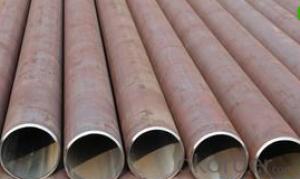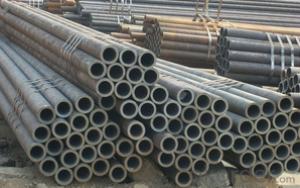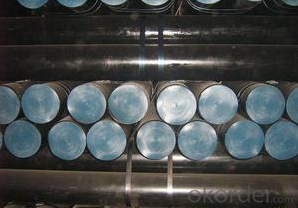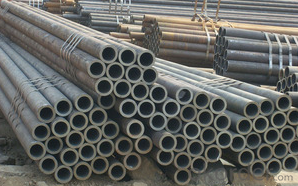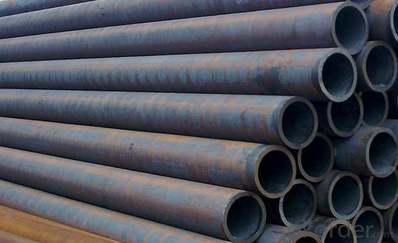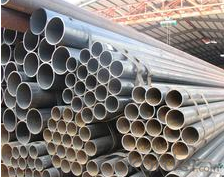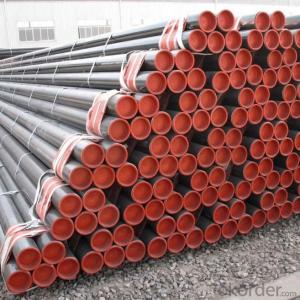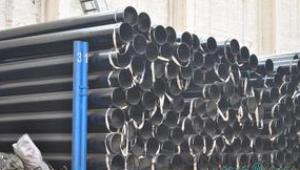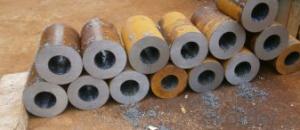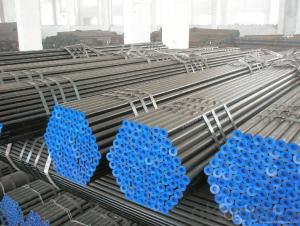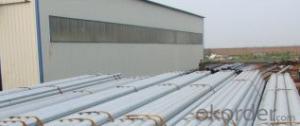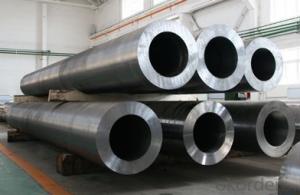Cold Drawn Carbon Steel Seamless Pipe a210 CNBM
- Loading Port:
- Qingdao
- Payment Terms:
- TT OR LC
- Min Order Qty:
- 10 pc
- Supply Capability:
- 30 pc/month
OKorder Service Pledge
OKorder Financial Service
You Might Also Like
Quick Details
| Thickness: | 1.2 - 20 mm | Section Shape: | Round | Outer Diameter: | 12.7 - 168 mm |
| Secondary Or Not: | Non-secondary | Application: | Boiler Pipe | ||
| Technique: | Cold Drawn | Certification: | PED | Surface Treatment: | oil coating |
| Special Pipe: | Thick Wall Pipe | Alloy Or Not: | Is Alloy | ASTM A213: | T2,T5,T9,T11,T12,T22,T23,T91,T91 |
| ASTM A335: | P1,P2,P5,P9,P11,P12,P22,P23,P91,P92 | DIN17175: | 15Mo3,10CrMo910,12CrMo195,13CrMo44 | Grade: | 12Cr1MoV,Cr5Mo,Cr9Mo,12Cr1MoVG,Cr5MoG,A335 P11,A335 P5,A335 P9,A335 P1,A213,A192,A210,A335 P12,A335 P23,St35.8,Cr-Mo alloy,A53-A369,ST35-ST52 |
| Standard: | BS 3059-2,DIN EN 10216-1-2004,DIN 17175,ASTM A213-2001,ANSI A210-1996,ASTM A179-1990,BS,DIN,ASTM |
Packaging & Delivery
| Packaging Detail: | Seaworthy export packing |
| Delivery Detail: | 45 Days |
Specifications
Standard:ASTM A179,DIN17175
Material:SA179,ST35.8
Size:12*1.2-168*20
Manufacture:cold drawn
Heat treating: normalized
Product Description
Commodity: cold drawn carbon steel seamless pipe
Standard&material: ASTM A213 T2,T5,T9,T11,T12,T22,T23,T91,T92, ASTM A335 P1,P2,P5,P9,P11,P12,P22,P23,P91,P92, DIN17175 15Mo3,10CrMo910,12CrMo195,13CrMo44, and equivalent standard and material.
Size range: 12mm*1.2mm - 168mm*20mm
Manufacture method: cold rolled, cold drawn
Delivery condition: Normalized, Normalized and Tempered.
Mill test certificate as per EN10204 3.1B is available.
Third party inspection is acceptable.
Tubes will be ECT+UT.
Packaging & Shipping
Packing: tubes will be packed in bundles tied with steel strips.
Oil coating,varnish,or black painting to be confirmed.
End plastic caps to be confirmed.
External packing by knit bags.
Marking: to be confirmed.
- Q: How do steel pipes compare to ductile iron pipes?
- Steel pipes and ductile iron pipes are utilized in various applications, but they possess distinct differences in terms of their properties and advantages. 1. Strength and Durability: Steel pipes exhibit greater strength and durability compared to ductile iron pipes. Steel possesses a higher tensile strength, making it less susceptible to cracking or breaking under pressure or external forces. Conversely, ductile iron possesses a lower tensile strength but boasts better impact resistance than steel. 2. Corrosion Resistance: Steel pipes are susceptible to corrosion, especially when exposed to moisture or chemicals. Nevertheless, protective measures such as applying coatings or employing corrosion-resistant alloys can safeguard against this. Ductile iron pipes, while inherently more corrosion-resistant than regular cast iron, may still necessitate external protection to prevent rusting and degradation. 3. Flexibility: Ductile iron pipes offer greater flexibility than steel pipes. They can endure certain degrees of bending and deflection without fracturing, making them suitable for applications where ground movement or shifting may occur. Conversely, steel pipes are less flexible and more rigid, rendering them better suited for straight runs or applications with minimal movement. 4. Cost: Generally, ductile iron pipes are more cost-effective than steel pipes. The manufacturing process for ductile iron is easier and cheaper, resulting in lower production costs. However, steel pipes may possess a longer lifespan, requiring fewer replacements over time, thereby offsetting the initial cost difference. 5. Installation: Steel pipes are lighter and easier to handle during installation compared to ductile iron pipes, which can be heavy and bulky. The lighter weight of steel pipes can reduce labor and transportation costs. Moreover, steel pipes can be welded, allowing for more flexible installation options, while ductile iron pipes are typically joined using mechanical couplings or flanged connections. In conclusion, steel pipes offer superior strength and durability, while ductile iron pipes provide better flexibility and cost-effectiveness. The selection between the two depends on the specific requirements of the application, including factors such as corrosion resistance, expected loads, installation conditions, and budget constraints.
- Q: What is DN50 for welded pipe?
- Commonly used in the market DN50 seamless steel pipe, the outer diameter has two specifications: A, 57mm, B, 60mm, if no special instructions, commonly used is 57mm. The outer diameter of the welded pipe is only 60mm this specification.
- Q: Can steel pipes be used for shipbuilding?
- Yes, steel pipes can be used for shipbuilding. Steel is a commonly used material in the construction of ships due to its strength, durability, and resistance to corrosion. Steel pipes are used for various purposes in shipbuilding, including the construction of the ship's hull, superstructure, and various internal systems such as plumbing, ventilation, and fuel lines. The strength and structural integrity of steel pipes make them suitable for withstanding the harsh conditions at sea, such as high pressures, extreme temperatures, and exposure to saltwater. Additionally, steel pipes can be easily welded and shaped to meet the specific requirements of shipbuilding, making them a versatile choice for this industry.
- Q: Can steel pipes be used for oil wells?
- Indeed, oil wells can utilize steel pipes. In the oil and gas sector, steel pipes are frequently employed owing to their robustness, longevity, and resistance to corrosion. They possess the capability to endure the immense pressures and temperatures experienced during oil well drilling and production. Moreover, steel pipes efficiently and securely transport oil from the well to the surface, making them the favored option for oil well infrastructure. Furthermore, steel pipes can be effortlessly welded and threaded, enabling convenient installation and maintenance in oil well applications.
- Q: Can steel pipes be used for underground heat exchange systems?
- Underground heat exchange systems can utilize steel pipes, which are known for their durability and strength against the pressure and environmental conditions underground. Steel is resistant to corrosion and can withstand high temperatures, allowing for efficient heat transport. Moreover, steel pipes are readily accessible and cost-effective compared to other materials, which contributes to their widespread use in underground heat exchange systems. Nevertheless, it is crucial to appropriately insulate and safeguard the steel pipes to prevent heat loss and potential harm caused by external elements like moisture or soil displacement.
- Q: Are steel pipes magnetic?
- Yes, steel pipes can be magnetic. Steel, which is primarily composed of iron, is a ferromagnetic material. This means that it can be magnetized or attracted to magnets. However, not all steel pipes are magnetic as the magnetic properties of steel can vary depending on the specific composition and production methods used. In some cases, steel can be made non-magnetic by adding certain alloying elements or by subjecting it to specific heat treatments. Additionally, the strength of the magnetic field that steel pipes can exhibit can vary depending on factors such as the thickness of the pipe and the strength of the magnet being used.
- Q: Are steel pipes suitable for wastewater pumping stations?
- Yes, steel pipes are suitable for wastewater pumping stations. Steel pipes are known for their durability and strength, making them an excellent choice for handling the harsh conditions and high-pressure requirements of wastewater pumping stations. They have the ability to withstand the corrosive nature of wastewater and can resist damage caused by chemicals and other aggressive substances commonly found in wastewater. Additionally, steel pipes are available in various sizes and thicknesses, allowing for customization to meet the specific needs of the pumping station. Furthermore, steel pipes can be easily welded and joined together, ensuring a secure and leak-free system. Overall, steel pipes offer a reliable and long-lasting solution for wastewater pumping stations.
- Q: How do you transport and store steel pipes?
- Transporting and storing steel pipes requires careful planning and adherence to safety guidelines. Here are the steps involved in transporting and storing steel pipes: 1. Determine the appropriate mode of transportation: Depending on the quantity and weight of the steel pipes, you can choose between transportation by truck, train, or ship. Evaluate the distance, logistics, and cost-effectiveness of each option before making a decision. 2. Package and secure the steel pipes: Proper packaging is crucial to prevent damage during transit. Bundle the pipes together using steel strapping or banding. Ensure that the bundles are secured tightly to prevent any shifting or movement during transportation. 3. Use appropriate lifting equipment: When loading and unloading the pipes, use suitable lifting equipment such as cranes, forklifts, or hoists. Ensure that the equipment is capable of handling the weight and length of the pipes safely. 4. Protect against moisture and corrosion: Steel pipes are susceptible to moisture and corrosion, which can weaken their structural integrity. Before transportation, apply a protective coating or wrap the pipes with waterproof materials. Additionally, consider using moisture-absorbing desiccants or placing the pipes on pallets to elevate them off the ground. 5. Plan for safe storage: If storing the steel pipes for an extended period, choose a dry and secure location. Ensure that the storage area is well-ventilated and free from direct exposure to sunlight, rain, or extreme temperatures. Use racks or pallets to keep the pipes off the ground and prevent contact with moisture. 6. Inspect for damage: Before transportation and after storage, conduct thorough inspections to identify any damage or signs of corrosion. This will help you address any issues promptly and ensure the integrity of the steel pipes. Remember to comply with local regulations and safety guidelines specific to your region when transporting and storing steel pipes. By following these steps, you can ensure the safe and efficient transportation and storage of steel pipes, minimizing the risk of damage and maintaining their quality.
- Q: What is the difference between steel pipe and concrete pipe?
- Steel pipe and concrete pipe are both commonly used for various applications, but they differ significantly in their material composition and properties. Firstly, the main difference lies in the materials used to manufacture these pipes. Steel pipes are made from steel, which is an alloy of iron and carbon. On the other hand, concrete pipes are made from a mixture of cement, aggregate (such as sand or gravel), and water. Secondly, steel pipes are known for their strength and durability. They can withstand high pressure, making them suitable for applications that require transporting fluids or gases under high pressure. Steel pipes also have a high resistance to corrosion, which is advantageous in environments where the pipe is exposed to moisture or chemicals. In contrast, concrete pipes are not as strong as steel pipes and are more prone to cracking or damage under high pressure. However, they are still capable of handling moderate pressure loads and are often used for drainage systems or sewage applications. Another significant difference is the installation process. Steel pipes are typically joined together using welding techniques, such as butt welding or socket welding. This creates a seamless and strong connection between the pipes. On the other hand, concrete pipes are often installed using rubber or gasketed joints, which are easier to assemble and disassemble. Cost is another factor where steel and concrete pipes differ. Steel pipes tend to be more expensive due to the higher cost of steel as a raw material and the additional labor required for welding and fabrication. Concrete pipes, on the other hand, are generally more cost-effective as the materials used in their production are more readily available and the installation process is simpler. In summary, the main differences between steel pipes and concrete pipes lie in their material composition, strength, resistance to corrosion, installation process, and cost. Steel pipes offer superior strength and durability, making them suitable for high-pressure applications and environments prone to corrosion. Concrete pipes, while not as strong, are cost-effective and commonly used for drainage systems or sewage applications.
- Q: How are steel pipes manufactured?
- Steel pipes are manufactured through a process called pipe manufacturing or pipe making, which involves various steps such as forming, welding, and finishing. The process starts with the procurement of raw materials, which are typically steel coils or sheets. These coils are then fed through a series of rollers to shape them into a cylindrical form. The edges of the coils are then welded together to create a continuous pipe. After welding, the pipes undergo various finishing processes such as sizing, straightening, and cutting to achieve the desired dimensions and specifications. Finally, the pipes are tested for quality assurance and may undergo additional treatments like galvanization or coating before being ready for use in different industries and applications.
Send your message to us
Cold Drawn Carbon Steel Seamless Pipe a210 CNBM
- Loading Port:
- Qingdao
- Payment Terms:
- TT OR LC
- Min Order Qty:
- 10 pc
- Supply Capability:
- 30 pc/month
OKorder Service Pledge
OKorder Financial Service
Similar products
Hot products
Hot Searches
Related keywords
